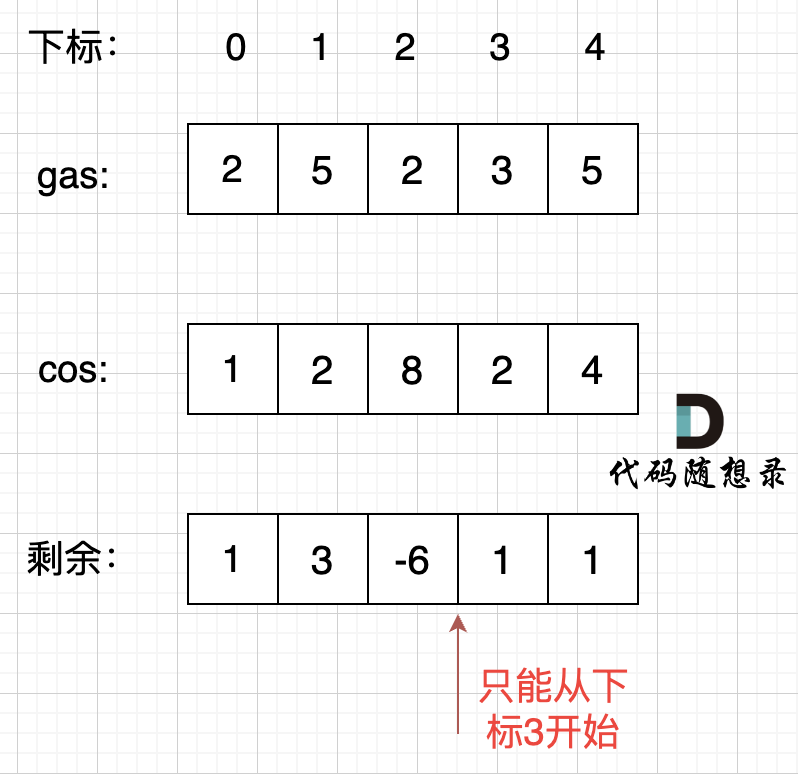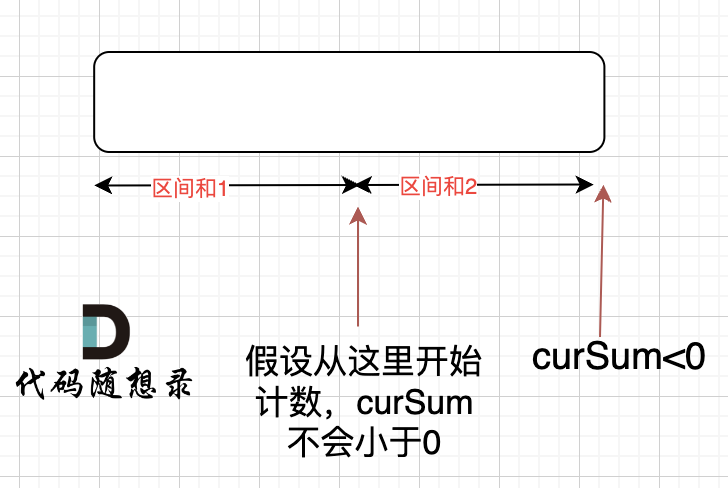参与本项目,贡献其他语言版本的代码,拥抱开源,让更多学习算法的小伙伴们收益!
在一条环路上有 N 个加油站,其中第 i 个加油站有汽油 gas[i] 升。
你有一辆油箱容量无限的的汽车,从第 i 个加油站开往第 i+1 个加油站需要消耗汽油 cost[i] 升。你从其中的一个加油站出发,开始时油箱为空。
如果你可以绕环路行驶一周,则返回出发时加油站的编号,否则返回 -1。
说明:
- 如果题目有解,该答案即为唯一答案。
- 输入数组均为非空数组,且长度相同。
- 输入数组中的元素均为非负数。
示例 1: 输入:
- gas = [1,2,3,4,5]
- cost = [3,4,5,1,2]
输出: 3 解释:
- 从 3 号加油站(索引为 3 处)出发,可获得 4 升汽油。此时油箱有 = 0 + 4 = 4 升汽油
- 开往 4 号加油站,此时油箱有 4 - 1 + 5 = 8 升汽油
- 开往 0 号加油站,此时油箱有 8 - 2 + 1 = 7 升汽油
- 开往 1 号加油站,此时油箱有 7 - 3 + 2 = 6 升汽油
- 开往 2 号加油站,此时油箱有 6 - 4 + 3 = 5 升汽油
- 开往 3 号加油站,你需要消耗 5 升汽油,正好足够你返回到 3 号加油站。
- 因此,3 可为起始索引。
示例 2: 输入:
-
gas = [2,3,4]
-
cost = [3,4,3]
-
输出: -1
-
解释: 你不能从 0 号或 1 号加油站出发,因为没有足够的汽油可以让你行驶到下一个加油站。我们从 2 号加油站出发,可以获得 4 升汽油。 此时油箱有 = 0 + 4 = 4 升汽油。开往 0 号加油站,此时油箱有 4 - 3 + 2 = 3 升汽油。开往 1 号加油站,此时油箱有 3 - 3 + 3 = 3 升汽油。你无法返回 2 号加油站,因为返程需要消耗 4 升汽油,但是你的油箱只有 3 升汽油。因此,无论怎样,你都不可能绕环路行驶一周。
《代码随想录》算法视频公开课:贪心算法,得这么加油才能跑完全程!LeetCode :134.加油站,相信结合视频在看本篇题解,更有助于大家对本题的理解。
暴力的方法很明显就是O(n^2)的,遍历每一个加油站为起点的情况,模拟一圈。
如果跑了一圈,中途没有断油,而且最后油量大于等于0,说明这个起点是ok的。
暴力的方法思路比较简单,但代码写起来也不是很容易,关键是要模拟跑一圈的过程。
for循环适合模拟从头到尾的遍历,而while循环适合模拟环形遍历,要善于使用while!
C++代码如下:
class Solution {
public:
int canCompleteCircuit(vector<int>& gas, vector<int>& cost) {
for (int i = 0; i < cost.size(); i++) {
int rest = gas[i] - cost[i]; // 记录剩余油量
int index = (i + 1) % cost.size();
while (rest > 0 && index != i) { // 模拟以i为起点行驶一圈(如果有rest==0,那么答案就不唯一了)
rest += gas[index] - cost[index];
index = (index + 1) % cost.size();
}
// 如果以i为起点跑一圈,剩余油量>=0,返回该起始位置
if (rest >= 0 && index == i) return i;
}
return -1;
}
};- 时间复杂度:O(n^2)
- 空间复杂度:O(1)
直接从全局进行贪心选择,情况如下:
-
情况一:如果gas的总和小于cost总和,那么无论从哪里出发,一定是跑不了一圈的
-
情况二:rest[i] = gas[i]-cost[i]为一天剩下的油,i从0开始计算累加到最后一站,如果累加没有出现负数,说明从0出发,油就没有断过,那么0就是起点。
-
情况三:如果累加的最小值是负数,汽车就要从非0节点出发,从后向前,看哪个节点能把这个负数填平,能把这个负数填平的节点就是出发节点。
C++代码如下:
class Solution {
public:
int canCompleteCircuit(vector<int>& gas, vector<int>& cost) {
int curSum = 0;
int min = INT_MAX; // 从起点出发,油箱里的油量最小值
for (int i = 0; i < gas.size(); i++) {
int rest = gas[i] - cost[i];
curSum += rest;
if (curSum < min) {
min = curSum;
}
}
if (curSum < 0) return -1; // 情况1
if (min >= 0) return 0; // 情况2
// 情况3
for (int i = gas.size() - 1; i >= 0; i--) {
int rest = gas[i] - cost[i];
min += rest;
if (min >= 0) {
return i;
}
}
return -1;
}
};- 时间复杂度:O(n)
- 空间复杂度:O(1)
其实我不认为这种方式是贪心算法,因为没有找出局部最优,而是直接从全局最优的角度上思考问题。
但这种解法又说不出是什么方法,这就是一个从全局角度选取最优解的模拟操作。
所以对于本解法是贪心,我持保留意见!
但不管怎么说,解法毕竟还是巧妙的,不用过于执着于其名字称呼。
可以换一个思路,首先如果总油量减去总消耗大于等于零那么一定可以跑完一圈,说明 各个站点的加油站 剩油量rest[i]相加一定是大于等于零的。
每个加油站的剩余量rest[i]为gas[i] - cost[i]。
i从0开始累加rest[i],和记为curSum,一旦curSum小于零,说明[0, i]区间都不能作为起始位置,因为这个区间选择任何一个位置作为起点,到i这里都会断油,那么起始位置从i+1算起,再从0计算curSum。
如图:
那么为什么一旦[0,i] 区间和为负数,起始位置就可以是i+1呢,i+1后面就不会出现更大的负数?
如果出现更大的负数,就是更新i,那么起始位置又变成新的i+1了。
那有没有可能 [0,i] 区间 选某一个作为起点,累加到 i这里 curSum是不会小于零呢? 如图:
如果 curSum<0 说明 区间和1 + 区间和2 < 0, 那么 假设从上图中的位置开始计数curSum不会小于0的话,就是 区间和2>0。
区间和1 + 区间和2 < 0 同时 区间和2>0,只能说明区间和1 < 0, 那么就会从假设的箭头初就开始从新选择其实位置了。
那么局部最优:当前累加rest[i]的和curSum一旦小于0,起始位置至少要是i+1,因为从i之前开始一定不行。全局最优:找到可以跑一圈的起始位置。
局部最优可以推出全局最优,找不出反例,试试贪心!
C++代码如下:
class Solution {
public:
int canCompleteCircuit(vector<int>& gas, vector<int>& cost) {
int curSum = 0;
int totalSum = 0;
int start = 0;
for (int i = 0; i < gas.size(); i++) {
curSum += gas[i] - cost[i];
totalSum += gas[i] - cost[i];
if (curSum < 0) { // 当前累加rest[i]和 curSum一旦小于0
start = i + 1; // 起始位置更新为i+1
curSum = 0; // curSum从0开始
}
}
if (totalSum < 0) return -1; // 说明怎么走都不可能跑一圈了
return start;
}
};- 时间复杂度:O(n)
- 空间复杂度:O(1)
说这种解法为贪心算法,才是有理有据的,因为全局最优解是根据局部最优推导出来的。
对于本题首先给出了暴力解法,暴力解法模拟跑一圈的过程其实比较考验代码技巧的,要对while使用的很熟练。
然后给出了两种贪心算法,对于第一种贪心方法,其实我认为就是一种直接从全局选取最优的模拟操作,思路还是很巧妙的,值得学习一下。
对于第二种贪心方法,才真正体现出贪心的精髓,用局部最优可以推出全局最优,进而求得起始位置。
// 解法1
class Solution {
public int canCompleteCircuit(int[] gas, int[] cost) {
int sum = 0;
int min = 0;
for (int i = 0; i < gas.length; i++) {
sum += (gas[i] - cost[i]);
min = Math.min(sum, min);
}
if (sum < 0) return -1;
if (min >= 0) return 0;
for (int i = gas.length - 1; i > 0; i--) {
min += (gas[i] - cost[i]);
if (min >= 0) return i;
}
return -1;
}
}// 解法2
class Solution {
public int canCompleteCircuit(int[] gas, int[] cost) {
int curSum = 0;
int totalSum = 0;
int index = 0;
for (int i = 0; i < gas.length; i++) {
curSum += gas[i] - cost[i];
totalSum += gas[i] - cost[i];
if (curSum < 0) {
index = (i + 1) % gas.length ;
curSum = 0;
}
}
if (totalSum < 0) return -1;
return index;
}
}暴力法
class Solution:
def canCompleteCircuit(self, gas: List[int], cost: List[int]) -> int:
for i in range(len(cost)):
rest = gas[i] - cost[i] # 记录剩余油量
index = (i + 1) % len(cost) # 下一个加油站的索引
while rest > 0 and index != i: # 模拟以i为起点行驶一圈(如果有rest==0,那么答案就不唯一了)
rest += gas[index] - cost[index] # 更新剩余油量
index = (index + 1) % len(cost) # 更新下一个加油站的索引
if rest >= 0 and index == i: # 如果以i为起点跑一圈,剩余油量>=0,并且回到起始位置
return i # 返回起始位置i
return -1 # 所有起始位置都无法环绕一圈,返回-1贪心(版本一)
class Solution:
def canCompleteCircuit(self, gas: List[int], cost: List[int]) -> int:
curSum = 0 # 当前累计的剩余油量
minFuel = float('inf') # 从起点出发,油箱里的油量最小值
for i in range(len(gas)):
rest = gas[i] - cost[i]
curSum += rest
if curSum < minFuel:
minFuel = curSum
if curSum < 0:
return -1 # 情况1:整个行程的总消耗大于总供给,无法完成一圈
if minFuel >= 0:
return 0 # 情况2:从起点出发到任何一个加油站时油箱的剩余油量都不会小于0,可以从起点出发完成一圈
for i in range(len(gas) - 1, -1, -1):
rest = gas[i] - cost[i]
minFuel += rest
if minFuel >= 0:
return i # 情况3:找到一个位置使得从该位置出发油箱的剩余油量不会小于0,返回该位置的索引
return -1 # 无法完成一圈贪心(版本二)
class Solution:
def canCompleteCircuit(self, gas: List[int], cost: List[int]) -> int:
curSum = 0 # 当前累计的剩余油量
totalSum = 0 # 总剩余油量
start = 0 # 起始位置
for i in range(len(gas)):
curSum += gas[i] - cost[i]
totalSum += gas[i] - cost[i]
if curSum < 0: # 当前累计剩余油量curSum小于0
start = i + 1 # 起始位置更新为i+1
curSum = 0 # curSum重新从0开始累计
if totalSum < 0:
return -1 # 总剩余油量totalSum小于0,说明无法环绕一圈
return start
func canCompleteCircuit(gas []int, cost []int) int {
curSum := 0
totalSum := 0
start := 0
for i := 0; i < len(gas); i++ {
curSum += gas[i] - cost[i]
totalSum += gas[i] - cost[i]
if curSum < 0 {
start = i+1
curSum = 0
}
}
if totalSum < 0 {
return -1
}
return start
}暴力:
var canCompleteCircuit = function(gas, cost) {
for(let i = 0; i < cost.length; i++) {
let rest = gas[i] - cost[i] //记录剩余油量
// 以i为起点行驶一圈,index为下一个目的地
let index = (i + 1) % cost.length
while(rest > 0 && index !== i) {
rest += gas[index] - cost[index]
index = (index + 1) % cost.length
}
if(rest >= 0 && index === i) return i
}
return -1
};解法一:
var canCompleteCircuit = function(gas, cost) {
let curSum = 0
let min = Infinity
for(let i = 0; i < gas.length; i++) {
let rest = gas[i] - cost[i]
curSum += rest
if(curSum < min) {
min = curSum
}
}
if(curSum < 0) return -1 //1.总油量 小于 总消耗量
if(min >= 0) return 0 //2. 说明油箱里油没断过
//3. 从后向前,看哪个节点能这个负数填平,能把这个负数填平的节点就是出发节点
for(let i = gas.length -1; i >= 0; i--) {
let rest = gas[i] - cost[i]
min += rest
if(min >= 0) {
return i
}
}
return -1
}解法二:
var canCompleteCircuit = function(gas, cost) {
const gasLen = gas.length
let start = 0
let curSum = 0
let totalSum = 0
for(let i = 0; i < gasLen; i++) {
curSum += gas[i] - cost[i]
totalSum += gas[i] - cost[i]
if(curSum < 0) {
curSum = 0
start = i + 1
}
}
if(totalSum < 0) return -1
return start
};暴力法:
function canCompleteCircuit(gas: number[], cost: number[]): number {
for (let i = 0, length = gas.length; i < length; i++) {
let curSum: number = 0;
let index: number = i;
while (curSum >= 0 && index < i + length) {
let tempIndex: number = index % length;
curSum += gas[tempIndex] - cost[tempIndex];
index++;
}
if (index === i + length && curSum >= 0) return i;
}
return -1;
};解法二:
function canCompleteCircuit(gas: number[], cost: number[]): number {
let total: number = 0;
let curGas: number = 0;
let tempDiff: number = 0;
let resIndex: number = 0;
for (let i = 0, length = gas.length; i < length; i++) {
tempDiff = gas[i] - cost[i];
total += tempDiff;
curGas += tempDiff;
if (curGas < 0) {
resIndex = i + 1;
curGas = 0;
}
}
if (total < 0) return -1;
return resIndex;
};贪心算法:方法一
impl Solution {
pub fn can_complete_circuit(gas: Vec<i32>, cost: Vec<i32>) -> i32 {
let mut cur_sum = 0;
let mut min = i32::MAX;
for i in 0..gas.len() {
let rest = gas[i] - cost[i];
cur_sum += rest;
if cur_sum < min { min = cur_sum; }
}
if cur_sum < 0 { return -1; }
if min > 0 { return 0; }
for i in (0..gas.len()).rev() {
let rest = gas[i] - cost[i];
min += rest;
if min >= 0 { return i as i32; }
}
-1
}
}贪心算法:方法二
impl Solution {
pub fn can_complete_circuit(gas: Vec<i32>, cost: Vec<i32>) -> i32 {
let mut cur_sum = 0;
let mut total_sum = 0;
let mut start = 0;
for i in 0..gas.len() {
cur_sum += gas[i] - cost[i];
total_sum += gas[i] - cost[i];
if cur_sum < 0 {
start = i + 1;
cur_sum = 0;
}
}
if total_sum < 0 { return -1; }
start as i32
}
}贪心算法:方法一
int canCompleteCircuit(int* gas, int gasSize, int* cost, int costSize){
int curSum = 0;
int i;
int min = INT_MAX;
//遍历整个数组。计算出每站的用油差。并将其与最小累加量比较
for(i = 0; i < gasSize; i++) {
int diff = gas[i] - cost[i];
curSum += diff;
if(curSum < min)
min = curSum;
}
//若汽油总数为负数,代表无法跑完一环。返回-1
if(curSum < 0)
return -1;
//若min大于等于0,说明每一天加油量比用油量多。因此从0出发即可
if(min >= 0)
return 0;
//若累加最小值为负,则找到一个非零元素(加油量大于出油量)出发。返回坐标
for(i = gasSize - 1; i >= 0; i--) {
min+=(gas[i]-cost[i]);
if(min >= 0)
return i;
}
//逻辑上不会返回这个0
return 0;
}贪心算法:方法二
int canCompleteCircuit(int* gas, int gasSize, int* cost, int costSize){
int curSum = 0;
int totalSum = 0;
int start = 0;
int i;
for(i = 0; i < gasSize; ++i) {
// 当前i站中加油量与耗油量的差
int diff = gas[i] - cost[i];
curSum += diff;
totalSum += diff;
// 若0到i的加油量都为负,则开始位置应为i+1
if(curSum < 0) {
curSum = 0;
// 当i + 1 == gasSize时,totalSum < 0(此时i为gasSize - 1),油车不可能返回原点
start = i + 1;
}
}
// 若总和小于0,加油车无论如何都无法返回原点。返回-1
if(totalSum < 0)
return -1;
return start;
}暴力解法:
object Solution {
def canCompleteCircuit(gas: Array[Int], cost: Array[Int]): Int = {
for (i <- cost.indices) {
var rest = gas(i) - cost(i)
var index = (i + 1) % cost.length // index为i的下一个节点
while (rest > 0 && i != index) {
rest += (gas(index) - cost(index))
index = (index + 1) % cost.length
}
if (rest >= 0 && index == i) return i
}
-1
}
}贪心算法,方法一:
object Solution {
def canCompleteCircuit(gas: Array[Int], cost: Array[Int]): Int = {
var curSum = 0
var min = Int.MaxValue
for (i <- gas.indices) {
var rest = gas(i) - cost(i)
curSum += rest
min = math.min(min, curSum)
}
if (curSum < 0) return -1 // 情况1: gas的总和小于cost的总和,不可能到达终点
if (min >= 0) return 0 // 情况2: 最小值>=0,从0号出发可以直接到达
// 情况3: min为负值,从后向前看,能把min填平的节点就是出发节点
for (i <- gas.length - 1 to 0 by -1) {
var rest = gas(i) - cost(i)
min += rest
if (min >= 0) return i
}
-1
}
}贪心算法,方法二:
object Solution {
def canCompleteCircuit(gas: Array[Int], cost: Array[Int]): Int = {
var curSum = 0
var totalSum = 0
var start = 0
for (i <- gas.indices) {
curSum += (gas(i) - cost(i))
totalSum += (gas(i) - cost(i))
if (curSum < 0) {
start = i + 1 // 起始位置更新
curSum = 0 // curSum从0开始
}
}
if (totalSum < 0) return -1 // 说明怎么走不可能跑一圈
start
}
}// 贪心算法,方法二
public class Solution
{
public int CanCompleteCircuit(int[] gas, int[] cost)
{
int curSum = 0, totalSum = 0, start = 0;
for (int i = 0; i < gas.Length; i++)
{
curSum += gas[i] - cost[i];
totalSum += gas[i] - cost[i];
if (curSum < 0)
{
start = i + 1;
curSum = 0;
}
}
if (totalSum < 0) return -1;
return start;
}
}


